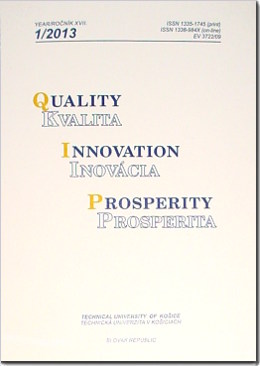Development of Quality Management Systems: How Have Disruptive Technological Innovations in Quality Management Affected Organizations?
Abstract
This research investigates the history of quality and development of quality management systems. History of quality is investigated from Hammurabi’s law all the way to today’s reigning quality initiatives including ISO, Six Sigma and Lean manufacturing. In the last chapters the current state of quality management is being examined. The foresight method is also opened up and examined. The Innovator’s dilemma concept, originally presented by Clayton Christensen, is used to analyse how quality management systems have been evolved in the last 100 years. Special emphasis is placed on the US manufacturing in the 1970s and 1980s. Based on the literature, the concept of Innovator’s dilemma and the fall of US manufacturing are merged. The result is a prime example that the Innovator’s Dilemma is a universal phenomenon. The industry leader is trying to maintain its position and do everything right but still it is destined to fail. The causes and effects are being discussed in later chapters.
Full text article
References
Abrahamson, E., Rosenkopf, L., 1990. When do bandwagon diffusion roll? How far do they go? And when do they roll backwards? Academy of Management: Best Paper Proceeding.
ASQ, 2013a. Glossary: Q. American Society for Quality. Available at: <http://asq.org/glossary/q.html> [Accessed 18 April 2013].
ASQ, 2013b. ASQ History. American Society for Quality. Available at: <http://asq.org/about-asq/who-we-are/history.html> [Accessed 18 April 2013].
ASQ, 2013e. Bio Philip Crosby. American Society for Quality. Available at: <http://asq.org/about-asq/who-we-are/bio_crosby.html> [Accessed 18 April 2013].
ASQ, 2013d. Bio Walter Deming. American Society for Quality. Available at: <http://asq.org/about-asq/who-we-are/bio_deming.html> [Accessed 18 April 2013].
ASQ, 2013c. Bio Joseph Juran. American Society for Quality. Available at:<http://asq.org/about-asq/who-we-are/bio_juran.html> [Accessed 18 April 2013].
Axelsson, J., and Bergman, B., 1999. The dynamics of quality and work life improvement – the Scandinavian heritage. The Nordic School of Quality Management. Lund: Studentlitteratur.
Cavanagh, R. R., Neuman, R. P., Pande, P. S., 2000. The Six Sigma Way. McGraw-Hill.
Christensen, C. M., 2006. The Innovator’s Dilemma. First Collins Business Essentials.
Edvardsson, B., Gustafsson, A., 1999. The Nordic School of Quality Management. Studentlitteratur.
Evans, J. R., 2008. Quality and Performance Excellence: Management, Organization, and Strategy. Mason, Ohio: Thomson Business and Economics.
Evans, J. R., Lindsay, W. M., 2008. Managing for Quality and Performance Excellence. Mason, Ohio: Thomson Business and Economics.
GE, 2013. What Is Six Sigma? General Electric. Available at: <http://www.ge.com/en/company/companyinfo/quality/whatis.htm> [Accessed 23 April 2013].
Hendricks, K. B., Singhal, V. R., 1997. Does Implementing an Effective TQM Program Actually Improve Operating Performance? Empirical Evidence from Firms That Have Won Quality Awards. Management Science, 43(9), pp.1258–1274.
Holpp, L., Pande, P., 2002. What is Six Sigma? McGraw-Hill.
ISO, 2013a. The ISO story. International Organization for Standardization. Available at: <http://www.iso.org/iso/home/about/the_iso_story.htm#12> [Accessed 24 April 2013].
ISO, 2013b. ISO 9000 Quality management. International Organization for Standardization, 2013. Available at: <http://www.iso.org/iso/home/standards/management-standards/iso_9000.htm> [Accessed 24 April 2013].
Levinson, W. A., Rerick, R. A., 2002. Lean Enterprise: A Synergistic Approach to Minimizing Waste. ASQ Quality Press.
Shaffie, S., Shahbazi, S., 2012. Lean Six Sigma. McGraw-Hill.
JUSE, 2013. Outline of JUSE. Union of Japanese Scientists and Engineers. Available at: <http://www.juse.or.jp/e/profile/39/> [Accessed 27 April 2013].
UNIDO, 2005. Technology foresight manual. Organization and Methods, Volume 1. Vienna, Austria: United Nations Industrial Development Organization.
U.S. Department of State, Office of the Historian, 2013. Occupation and Reconstruction of Japan, 1945-52, Available at: <http://history.state.gov/milestones/1945-1952/JapanReconstruction> [Accessed 28 April 2013].
Authors
This is an open access journal which means that all content is freely available without charge to the user or his/her institution. Users are allowed to read, download, copy, distribute, print, search, or link to the full texts of the articles in this journal without asking prior permission from the publisher or the author. This is in accordance with the BOAI definition of open access. This journal is licensed under a Creative Commons Attribution 4.0 License - http://creativecommons.org/licenses/by/4.0.
Authors who publish with the Quality Innovation Prosperity agree to the following terms:
- Authors retain copyright and grant the journal right of first publication with the work simultaneously licensed under a Creative Commons Attribution License that allows others to share the work with an acknowledgement of the work's authorship and initial publication in this journal.
- Authors are able to enter into separate, additional contractual arrangements for the non-exclusive distribution of the journal's published version of the work (e.g., post it to an institutional repository or publish it in a book), with an acknowledgement of its initial publication in this journal.
- Authors are permitted and encouraged to post their work online (e.g., in institutional repositories or on their website) prior to and during the submission process, as it can lead to productive exchanges, as well as earlier and greater citation of published work.


